Unit 5 Our toys Lesson 1 Welcome to the toy shop 教学设计
文档属性
| 名称 | Unit 5 Our toys Lesson 1 Welcome to the toy shop 教学设计 | 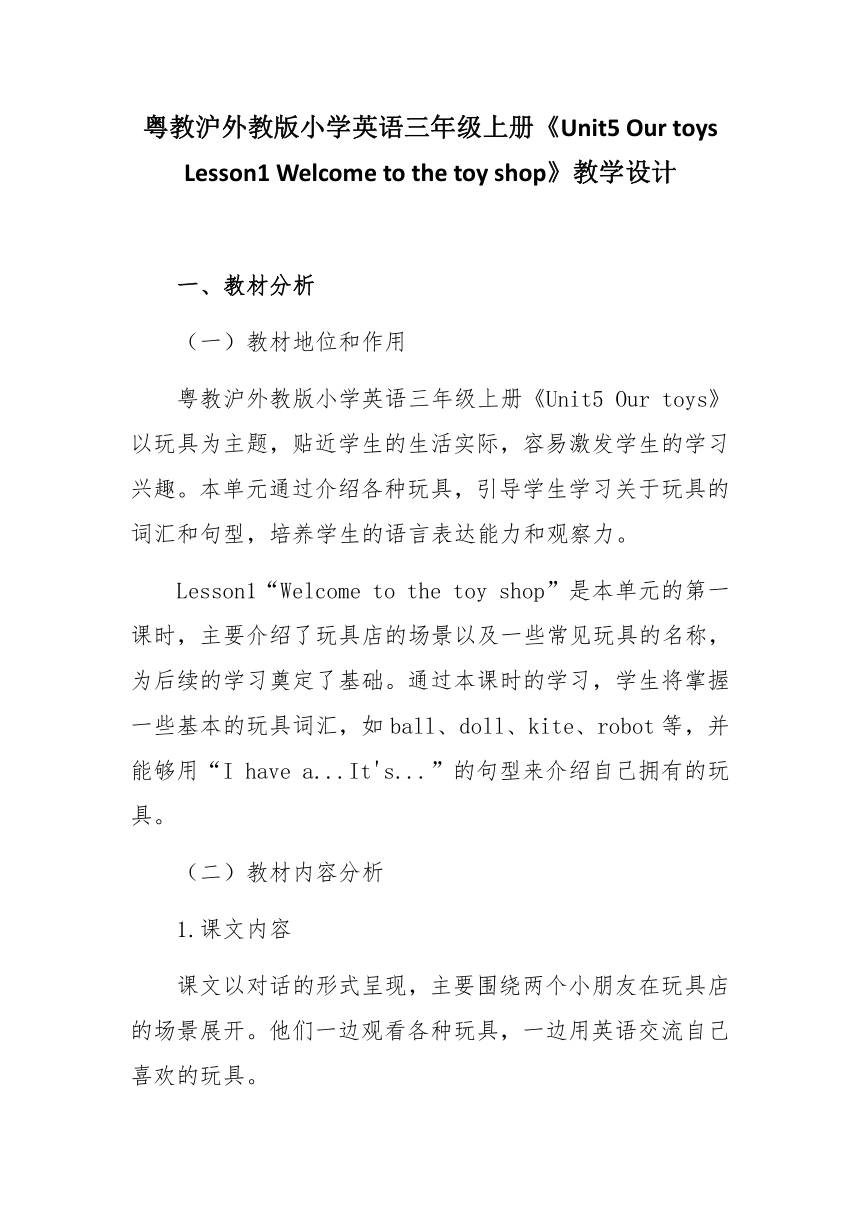 | |
| 格式 | docx | ||
| 文件大小 | 24.2KB | ||
| 资源类型 | 教案 | ||
| 版本资源 | 粤教沪外教版 | ||
| 科目 | 英语 | ||
| 更新时间 | 2024-12-23 19:45:33 | ||
图片预览

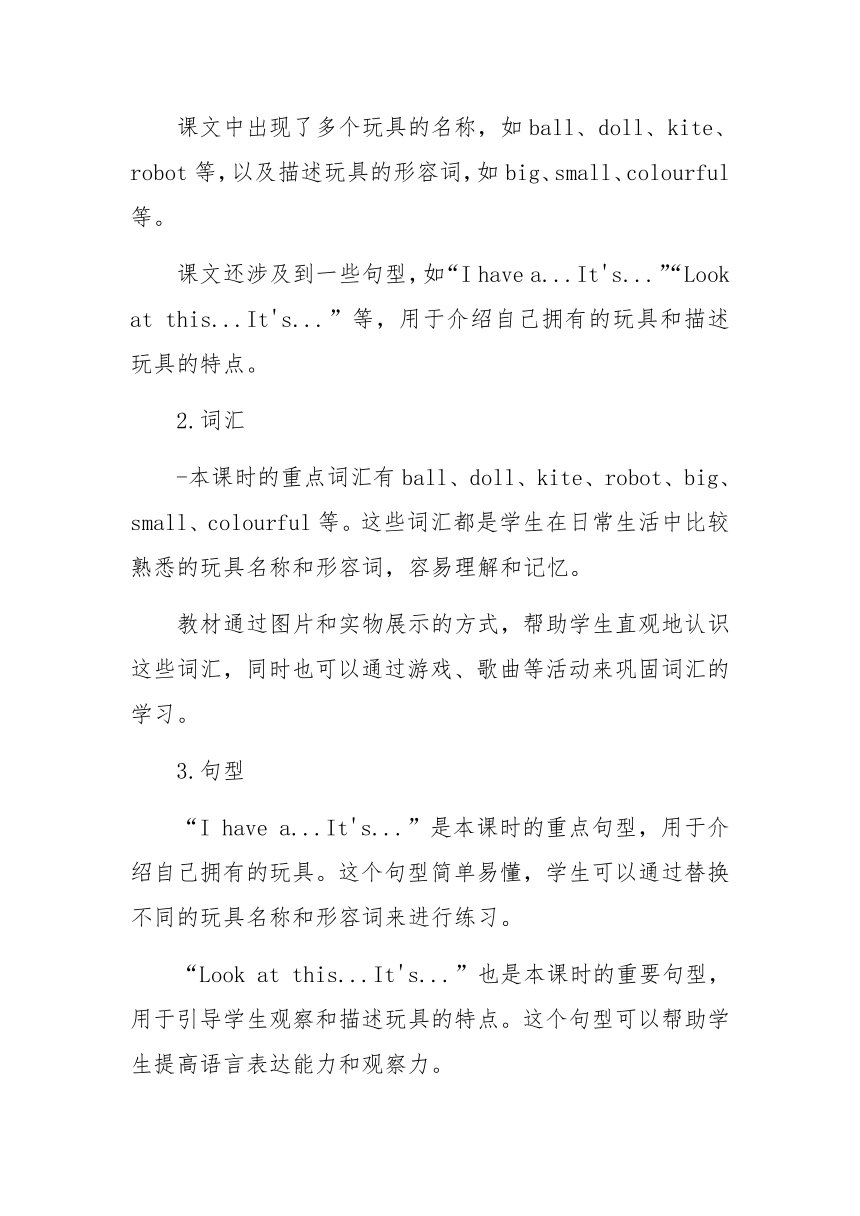
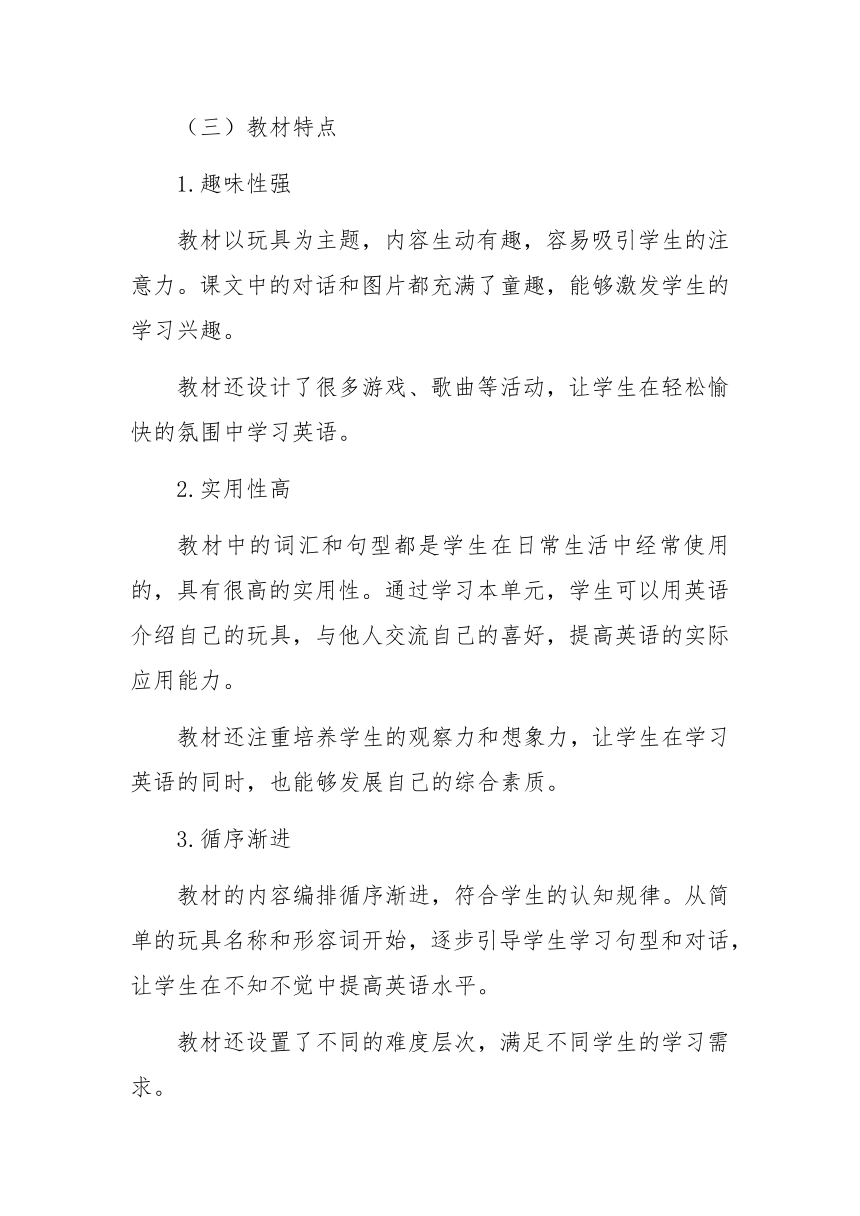
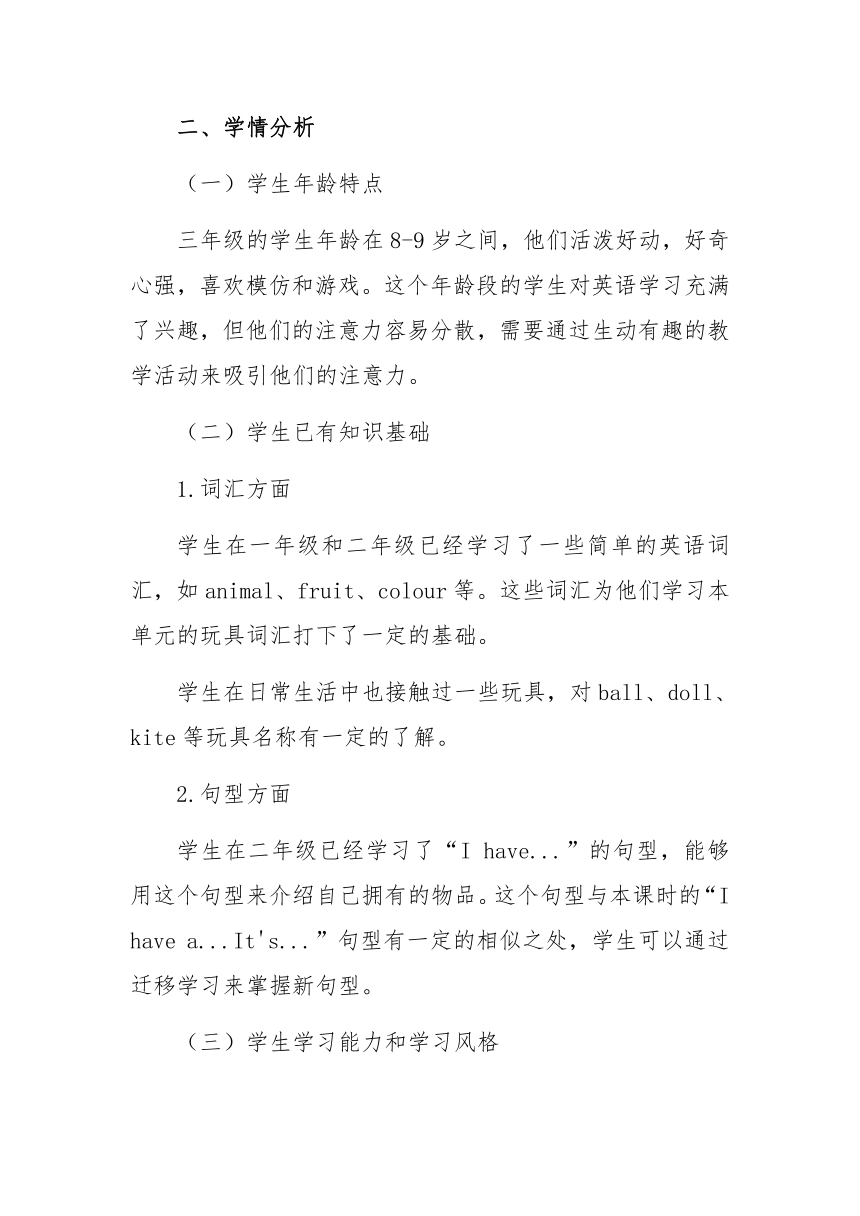
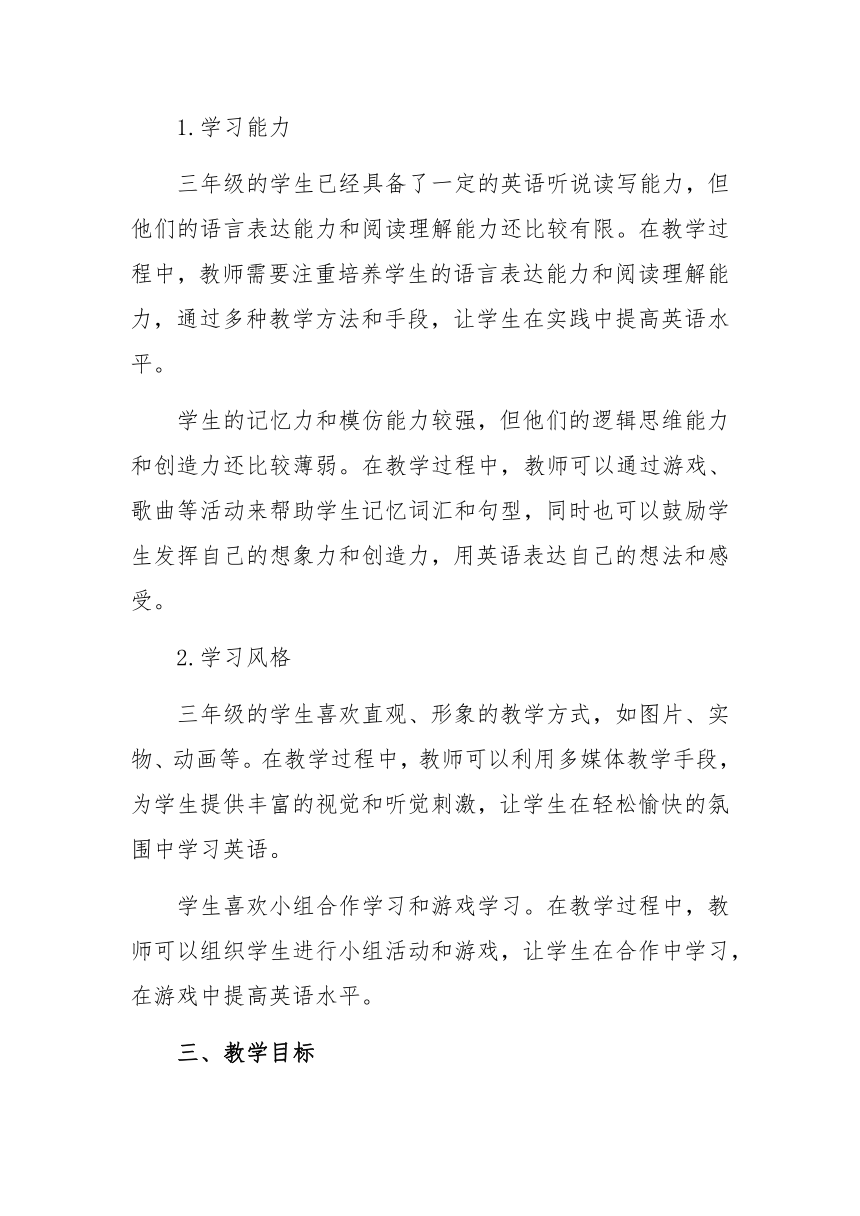
文档简介
粤教沪外教版小学英语三年级上册《Unit5 Our toys Lesson1 Welcome to the toy shop》教学设计
一、教材分析
(一)教材地位和作用
粤教沪外教版小学英语三年级上册《Unit5 Our toys》以玩具为主题,贴近学生的生活实际,容易激发学生的学习兴趣。本单元通过介绍各种玩具,引导学生学习关于玩具的词汇和句型,培养学生的语言表达能力和观察力。
Lesson1“Welcome to the toy shop”是本单元的第一课时,主要介绍了玩具店的场景以及一些常见玩具的名称,为后续的学习奠定了基础。通过本课时的学习,学生将掌握一些基本的玩具词汇,如ball、doll、kite、robot等,并能够用“I have a...It's...”的句型来介绍自己拥有的玩具。
(二)教材内容分析
1.课文内容
课文以对话的形式呈现,主要围绕两个小朋友在玩具店的场景展开。他们一边观看各种玩具,一边用英语交流自己喜欢的玩具。
课文中出现了多个玩具的名称,如ball、doll、kite、robot等,以及描述玩具的形容词,如big、small、colourful等。
课文还涉及到一些句型,如“I have a...It's...”“Look at this...It's...”等,用于介绍自己拥有的玩具和描述玩具的特点。
2.词汇
-本课时的重点词汇有ball、doll、kite、robot、big、small、colourful等。这些词汇都是学生在日常生活中比较熟悉的玩具名称和形容词,容易理解和记忆。
教材通过图片和实物展示的方式,帮助学生直观地认识这些词汇,同时也可以通过游戏、歌曲等活动来巩固词汇的学习。
3.句型
“I have a...It's...”是本课时的重点句型,用于介绍自己拥有的玩具。这个句型简单易懂,学生可以通过替换不同的玩具名称和形容词来进行练习。
“Look at this...It's...”也是本课时的重要句型,用于引导学生观察和描述玩具的特点。这个句型可以帮助学生提高语言表达能力和观察力。
(三)教材特点
1.趣味性强
教材以玩具为主题,内容生动有趣,容易吸引学生的注意力。课文中的对话和图片都充满了童趣,能够激发学生的学习兴趣。
教材还设计了很多游戏、歌曲等活动,让学生在轻松愉快的氛围中学习英语。
2.实用性高
教材中的词汇和句型都是学生在日常生活中经常使用的,具有很高的实用性。通过学习本单元,学生可以用英语介绍自己的玩具,与他人交流自己的喜好,提高英语的实际应用能力。
教材还注重培养学生的观察力和想象力,让学生在学习英语的同时,也能够发展自己的综合素质。
3.循序渐进
教材的内容编排循序渐进,符合学生的认知规律。从简单的玩具名称和形容词开始,逐步引导学生学习句型和对话,让学生在不知不觉中提高英语水平。
教材还设置了不同的难度层次,满足不同学生的学习需求。
二、学情分析
(一)学生年龄特点
三年级的学生年龄在8-9岁之间,他们活泼好动,好奇心强,喜欢模仿和游戏。这个年龄段的学生对英语学习充满了兴趣,但他们的注意力容易分散,需要通过生动有趣的教学活动来吸引他们的注意力。
(二)学生已有知识基础
1.词汇方面
学生在一年级和二年级已经学习了一些简单的英语词汇,如animal、fruit、colour等。这些词汇为他们学习本单元的玩具词汇打下了一定的基础。
学生在日常生活中也接触过一些玩具,对ball、doll、kite等玩具名称有一定的了解。
2.句型方面
学生在二年级已经学习了“I have...”的句型,能够用这个句型来介绍自己拥有的物品。这个句型与本课时的“I have a...It's...”句型有一定的相似之处,学生可以通过迁移学习来掌握新句型。
(三)学生学习能力和学习风格
1.学习能力
三年级的学生已经具备了一定的英语听说读写能力,但他们的语言表达能力和阅读理解能力还比较有限。在教学过程中,教师需要注重培养学生的语言表达能力和阅读理解能力,通过多种教学方法和手段,让学生在实践中提高英语水平。
学生的记忆力和模仿能力较强,但他们的逻辑思维能力和创造力还比较薄弱。在教学过程中,教师可以通过游戏、歌曲等活动来帮助学生记忆词汇和句型,同时也可以鼓励学生发挥自己的想象力和创造力,用英语表达自己的想法和感受。
2.学习风格
三年级的学生喜欢直观、形象的教学方式,如图片、实物、动画等。在教学过程中,教师可以利用多媒体教学手段,为学生提供丰富的视觉和听觉刺激,让学生在轻松愉快的氛围中学习英语。
学生喜欢小组合作学习和游戏学习。在教学过程中,教师可以组织学生进行小组活动和游戏,让学生在合作中学习,在游戏中提高英语水平。
三、教学目标
(一)知识目标
1.学生能够听懂、会说、认读单词ball、doll、kite、robot、big、small、colourful。
2.学生能够理解并运用句型“I have a...It's...”“Look at this...It's...”来介绍自己拥有的玩具和描述玩具的特点。
(二)能力目标
1.培养学生的听、说、读、写能力,使学生能够用英语进行简单的交流和表达。
2.培养学生的观察力和想象力,让学生能够观察和描述玩具的特点。
3.培养学生的合作学习能力和自主学习能力,让学生在小组活动和自主学习中提高英语水平。
(三)情感目标
1.激发学生学习英语的兴趣,让学生在轻松愉快的氛围中学习英语。
2.培养学生的审美情趣,让学生学会欣赏美丽的事物。
3.培养学生的分享意识,让学生学会与他人分享自己的玩具和快乐。
四、教学重难点
(一)教学重点
1.掌握单词ball、doll、kite、robot、big、small、colourful的发音和含义。
2.掌握句型“I have a...It's...”“Look at this...It's...”的用法,并能够用这些句型来介绍自己拥有的玩具和描述玩具的特点。
(二)教学难点
1.单词robot的发音。
2.句型“I have a...It's...”“Look at this...It's...”的灵活运用。
五、教学策略
(一)情景教学法
通过创设玩具店的情景,让学生在真实的语境中学习英语。在情景中,学生可以更加直观地理解词汇和句型的含义,提高语言的实际应用能力。
(二)游戏教学法
设计各种有趣的游戏活动,如“猜谜语”“单词接龙”“角色扮演”等,让学生在游戏中学习英语。游戏可以激发学生的学习兴趣,提高学生的参与度,同时也可以帮助学生巩固所学的知识。
(三)合作学习法
组织学生进行小组活动,让学生在合作中学习英语。小组活动可以培养学生的合作学习能力和团队精神,同时也可以让学生在互相交流和帮助中提高英语水平。
(四)多媒体教学法
利用多媒体教学手段,如图片、动画、视频等,为学生提供丰富的视觉和听觉刺激,让学生在轻松愉快的氛围中学习英语。多媒体教学可以提高教学的趣味性和效率,同时也可以帮助学生更好地理解和掌握所学的知识。
六、教学准备
(一)教师准备
1.准备教学课件,包括图片、动画、视频等。
2.准备玩具实物,如ball、doll、kite、robot等。
3.准备单词卡片和句型卡片。
4.准备奖励贴纸和小礼品。
(二)学生准备
1.准备自己喜欢的玩具。
2.准备英语课本和练习本。
七、教学过程
(一)Warming up
1.Greetings
T:Hello,boys and girls!Nice to see you again!
Ss:Hello,teacher!Nice to see you,too!
T:How are you today
Ss:I'm fine,thank you.And you
T:I'm very well,too.Thanks.
设计意图:通过简单的问候,拉近师生之间的距离,营造轻松愉快的课堂氛围。
2.Sing a song
T:Now,let's sing a song together.“If you're happy and you know it,clap your hands.”
Ss:(Sing the song)
设计意图:通过唱歌的方式,激发学生的学习兴趣,让学生在轻松愉快的氛围中开始英语学习。
(二)Lead in
1.Show some pictures of toys
T:Look at these pictures.What are they
Ss:They are toys.
T:Yes,they are toys.Do you like toys
Ss:Yes,we do.
设计意图:通过展示玩具图片,引出本单元的主题“toys”,激发学生的学习兴趣。
2.Ask some questions about toys
T:What's your favourite toy
S1:My favourite toy is a doll.
T:Why do you like it
S1:Because it's very beautiful.
T:What can you do with your favourite toy
S2:I can play with it.
T:Great!Now,let's go to a toy shop and see some more toys.
设计意图:通过提问的方式,了解学生对玩具的喜好和使用方式,为后续的学习做好铺垫。
(三)Presentation
1.Learn the new words
Show a picture of a toy shop
T:Look!This is a toy shop.There are many toys in it.What can you see
Ss:I can see a ball,a doll,a kite and a robot.
T:Yes,you are right.Now,let's learn these new words.
(1)Teach the word“ball”
Show a picture of a ball
T:Look at this.It's a ball.It's big and round.Can you say“ball”
Ss:Ball.
T:Good!Now,let's read it together.Ball,ball,a ball.
Ss:Ball,ball,a ball.
(2)Teach the word“doll”
Show a picture of a doll
T:Look at this.It's a doll.It's very beautiful.Can you say“doll”
Ss:Doll.
T:Good!Now,let's read it together.Doll,doll,a doll.
Ss:Doll,doll,a doll.
(3)Teach the word“kite”
Show a picture of a kite
T:Look at this.It's a kite.It's colourful.Can you say“kite”
Ss:Kite.
T:Good!Now,let's read it together.Kite,kite,a kite.
Ss:Kite,kite,a kite.
(4)Teach the word“robot”
Show a picture of a robot
T:Look at this.It's a robot.It can walk and talk.Can you say“robot”
Ss:Robot.
T:Good!But pay attention to the pronunciation.The“o”in“robot”is pronounced as/ /.Now,let's read it together.Robot,robot,a robot.
Ss:Robot,robot,a robot.
设计意图:通过图片展示的方式,引出本课时的重点词汇,让学生直观地认识这些词汇。同时,通过描述玩具的特点,帮助学生理解词汇的含义,提高学生的语言表达能力。
2.Learn the new sentences
(1)Teach the sentence“I have a...It's...”
Show a picture of a ball
T:Look!I have a ball.It's big and round.Can you say“I have a ball.It's big and round.”
Ss:I have a ball.It's big and round.
T:Good!Now,let's read it together.I have a ball.It's big and round.
Ss:I have a ball.It's big and round.
(2)Teach the sentence“Look at this...It's...”
Show a picture of a doll
T:Look at this doll.It's very beautiful.Can you say“Look at this doll.It's very beautiful.”
Ss:Look at this doll.It's very beautiful.
T:Good!Now,let's read it together.Look at this doll.It's very beautiful.
Ss:Look at this doll.It's very beautiful.
设计意图:通过图片展示和例句引导的方式,引出本课时的重点句型,让学生理解句型的用法。同时,通过反复朗读的方式,帮助学生掌握句型的发音和语调。
(四)Practice
1.Game:“What's missing ”
Show some pictures of toys on the PPT.Then,cover one of the pictures and ask the students to guess what's missing.
T:Look at these pictures.What's missing
Ss:A ball is missing./A doll is missing./A kite is missing./A robot is missing.
设计意图:通过游戏的方式,巩固学生对玩具词汇的掌握,提高学生的观察力和记忆力。
2.Game:“Word chain”
Divide the students into several groups.Then,ask the students to take turns to say a toy word.The next student should say a new toy word that starts with the last letter of the previous word.
T:Now,let's play a game.It's called“Word chain”.For example,if I say“ball”,the next student should say a word that starts with“l”.Can you understand
Ss:Yes.
T:OK.Let's start.I say“ball”.
S1:“Lion”.
T:No,it's wrong.The word should be a toy word.Let's try again.I say“ball”.
S2:“Lego”.
T:Good!Now,it's your turn.
设计意图:通过游戏的方式,巩固学生对玩具词汇的掌握,提高学生的反应能力和词汇量。
3.Pair work
Ask the students to work in pairs.One student shows a toy and says“I have a...It's...”.The other student says“Look at this...It's...”.Then,they exchange roles.
T:Now,let's work in pairs.One student shows a toy and says“I have a...It's...”.The other student says“Look at this...It's...”.Then,they exchange roles.
Ss:(Work in pairs)
设计意图:通过小组活动的方式,让学生在实际情境中运用所学的句型,提高学生的语言表达能力和合作学习能力。
(五)Consolidation
1.Summary
T:Today,we learned some new words and sentences.What are they
Ss:We learned the words“ball”,“doll”,“kite”,“robot”,“big”,“small”,“colourful”.And we learned the sentences“I have a...It's...”“Look at this...It's...”
T:Very good!Now,let's read these words and sentences together.
设计意图:通过总结的方式,帮助学生回顾本课时所学的内容,加深学生的记忆。
2.Extension
Ask the students to describe their own toys using the words and sentences they learned.
T:Now,let's describe our own toys.You can use the words and sentences we learned.For example,you can say“I have a doll.It's very beautiful.It's big and soft.”
Ss:(Describe their own toys)
设计意图:通过拓展活动的方式,让学生将所学的知识运用到实际生活中,提高学生的语言运用能力。
(六)Homework
1.Listen to the tape and read the text three times.
2.Draw a picture of your favourite toy and describe it in English.
设计意图:通过布置作业的方式,让学生巩固所学的知识,提高学生的英语听说读写能力。
一、教材分析
(一)教材地位和作用
粤教沪外教版小学英语三年级上册《Unit5 Our toys》以玩具为主题,贴近学生的生活实际,容易激发学生的学习兴趣。本单元通过介绍各种玩具,引导学生学习关于玩具的词汇和句型,培养学生的语言表达能力和观察力。
Lesson1“Welcome to the toy shop”是本单元的第一课时,主要介绍了玩具店的场景以及一些常见玩具的名称,为后续的学习奠定了基础。通过本课时的学习,学生将掌握一些基本的玩具词汇,如ball、doll、kite、robot等,并能够用“I have a...It's...”的句型来介绍自己拥有的玩具。
(二)教材内容分析
1.课文内容
课文以对话的形式呈现,主要围绕两个小朋友在玩具店的场景展开。他们一边观看各种玩具,一边用英语交流自己喜欢的玩具。
课文中出现了多个玩具的名称,如ball、doll、kite、robot等,以及描述玩具的形容词,如big、small、colourful等。
课文还涉及到一些句型,如“I have a...It's...”“Look at this...It's...”等,用于介绍自己拥有的玩具和描述玩具的特点。
2.词汇
-本课时的重点词汇有ball、doll、kite、robot、big、small、colourful等。这些词汇都是学生在日常生活中比较熟悉的玩具名称和形容词,容易理解和记忆。
教材通过图片和实物展示的方式,帮助学生直观地认识这些词汇,同时也可以通过游戏、歌曲等活动来巩固词汇的学习。
3.句型
“I have a...It's...”是本课时的重点句型,用于介绍自己拥有的玩具。这个句型简单易懂,学生可以通过替换不同的玩具名称和形容词来进行练习。
“Look at this...It's...”也是本课时的重要句型,用于引导学生观察和描述玩具的特点。这个句型可以帮助学生提高语言表达能力和观察力。
(三)教材特点
1.趣味性强
教材以玩具为主题,内容生动有趣,容易吸引学生的注意力。课文中的对话和图片都充满了童趣,能够激发学生的学习兴趣。
教材还设计了很多游戏、歌曲等活动,让学生在轻松愉快的氛围中学习英语。
2.实用性高
教材中的词汇和句型都是学生在日常生活中经常使用的,具有很高的实用性。通过学习本单元,学生可以用英语介绍自己的玩具,与他人交流自己的喜好,提高英语的实际应用能力。
教材还注重培养学生的观察力和想象力,让学生在学习英语的同时,也能够发展自己的综合素质。
3.循序渐进
教材的内容编排循序渐进,符合学生的认知规律。从简单的玩具名称和形容词开始,逐步引导学生学习句型和对话,让学生在不知不觉中提高英语水平。
教材还设置了不同的难度层次,满足不同学生的学习需求。
二、学情分析
(一)学生年龄特点
三年级的学生年龄在8-9岁之间,他们活泼好动,好奇心强,喜欢模仿和游戏。这个年龄段的学生对英语学习充满了兴趣,但他们的注意力容易分散,需要通过生动有趣的教学活动来吸引他们的注意力。
(二)学生已有知识基础
1.词汇方面
学生在一年级和二年级已经学习了一些简单的英语词汇,如animal、fruit、colour等。这些词汇为他们学习本单元的玩具词汇打下了一定的基础。
学生在日常生活中也接触过一些玩具,对ball、doll、kite等玩具名称有一定的了解。
2.句型方面
学生在二年级已经学习了“I have...”的句型,能够用这个句型来介绍自己拥有的物品。这个句型与本课时的“I have a...It's...”句型有一定的相似之处,学生可以通过迁移学习来掌握新句型。
(三)学生学习能力和学习风格
1.学习能力
三年级的学生已经具备了一定的英语听说读写能力,但他们的语言表达能力和阅读理解能力还比较有限。在教学过程中,教师需要注重培养学生的语言表达能力和阅读理解能力,通过多种教学方法和手段,让学生在实践中提高英语水平。
学生的记忆力和模仿能力较强,但他们的逻辑思维能力和创造力还比较薄弱。在教学过程中,教师可以通过游戏、歌曲等活动来帮助学生记忆词汇和句型,同时也可以鼓励学生发挥自己的想象力和创造力,用英语表达自己的想法和感受。
2.学习风格
三年级的学生喜欢直观、形象的教学方式,如图片、实物、动画等。在教学过程中,教师可以利用多媒体教学手段,为学生提供丰富的视觉和听觉刺激,让学生在轻松愉快的氛围中学习英语。
学生喜欢小组合作学习和游戏学习。在教学过程中,教师可以组织学生进行小组活动和游戏,让学生在合作中学习,在游戏中提高英语水平。
三、教学目标
(一)知识目标
1.学生能够听懂、会说、认读单词ball、doll、kite、robot、big、small、colourful。
2.学生能够理解并运用句型“I have a...It's...”“Look at this...It's...”来介绍自己拥有的玩具和描述玩具的特点。
(二)能力目标
1.培养学生的听、说、读、写能力,使学生能够用英语进行简单的交流和表达。
2.培养学生的观察力和想象力,让学生能够观察和描述玩具的特点。
3.培养学生的合作学习能力和自主学习能力,让学生在小组活动和自主学习中提高英语水平。
(三)情感目标
1.激发学生学习英语的兴趣,让学生在轻松愉快的氛围中学习英语。
2.培养学生的审美情趣,让学生学会欣赏美丽的事物。
3.培养学生的分享意识,让学生学会与他人分享自己的玩具和快乐。
四、教学重难点
(一)教学重点
1.掌握单词ball、doll、kite、robot、big、small、colourful的发音和含义。
2.掌握句型“I have a...It's...”“Look at this...It's...”的用法,并能够用这些句型来介绍自己拥有的玩具和描述玩具的特点。
(二)教学难点
1.单词robot的发音。
2.句型“I have a...It's...”“Look at this...It's...”的灵活运用。
五、教学策略
(一)情景教学法
通过创设玩具店的情景,让学生在真实的语境中学习英语。在情景中,学生可以更加直观地理解词汇和句型的含义,提高语言的实际应用能力。
(二)游戏教学法
设计各种有趣的游戏活动,如“猜谜语”“单词接龙”“角色扮演”等,让学生在游戏中学习英语。游戏可以激发学生的学习兴趣,提高学生的参与度,同时也可以帮助学生巩固所学的知识。
(三)合作学习法
组织学生进行小组活动,让学生在合作中学习英语。小组活动可以培养学生的合作学习能力和团队精神,同时也可以让学生在互相交流和帮助中提高英语水平。
(四)多媒体教学法
利用多媒体教学手段,如图片、动画、视频等,为学生提供丰富的视觉和听觉刺激,让学生在轻松愉快的氛围中学习英语。多媒体教学可以提高教学的趣味性和效率,同时也可以帮助学生更好地理解和掌握所学的知识。
六、教学准备
(一)教师准备
1.准备教学课件,包括图片、动画、视频等。
2.准备玩具实物,如ball、doll、kite、robot等。
3.准备单词卡片和句型卡片。
4.准备奖励贴纸和小礼品。
(二)学生准备
1.准备自己喜欢的玩具。
2.准备英语课本和练习本。
七、教学过程
(一)Warming up
1.Greetings
T:Hello,boys and girls!Nice to see you again!
Ss:Hello,teacher!Nice to see you,too!
T:How are you today
Ss:I'm fine,thank you.And you
T:I'm very well,too.Thanks.
设计意图:通过简单的问候,拉近师生之间的距离,营造轻松愉快的课堂氛围。
2.Sing a song
T:Now,let's sing a song together.“If you're happy and you know it,clap your hands.”
Ss:(Sing the song)
设计意图:通过唱歌的方式,激发学生的学习兴趣,让学生在轻松愉快的氛围中开始英语学习。
(二)Lead in
1.Show some pictures of toys
T:Look at these pictures.What are they
Ss:They are toys.
T:Yes,they are toys.Do you like toys
Ss:Yes,we do.
设计意图:通过展示玩具图片,引出本单元的主题“toys”,激发学生的学习兴趣。
2.Ask some questions about toys
T:What's your favourite toy
S1:My favourite toy is a doll.
T:Why do you like it
S1:Because it's very beautiful.
T:What can you do with your favourite toy
S2:I can play with it.
T:Great!Now,let's go to a toy shop and see some more toys.
设计意图:通过提问的方式,了解学生对玩具的喜好和使用方式,为后续的学习做好铺垫。
(三)Presentation
1.Learn the new words
Show a picture of a toy shop
T:Look!This is a toy shop.There are many toys in it.What can you see
Ss:I can see a ball,a doll,a kite and a robot.
T:Yes,you are right.Now,let's learn these new words.
(1)Teach the word“ball”
Show a picture of a ball
T:Look at this.It's a ball.It's big and round.Can you say“ball”
Ss:Ball.
T:Good!Now,let's read it together.Ball,ball,a ball.
Ss:Ball,ball,a ball.
(2)Teach the word“doll”
Show a picture of a doll
T:Look at this.It's a doll.It's very beautiful.Can you say“doll”
Ss:Doll.
T:Good!Now,let's read it together.Doll,doll,a doll.
Ss:Doll,doll,a doll.
(3)Teach the word“kite”
Show a picture of a kite
T:Look at this.It's a kite.It's colourful.Can you say“kite”
Ss:Kite.
T:Good!Now,let's read it together.Kite,kite,a kite.
Ss:Kite,kite,a kite.
(4)Teach the word“robot”
Show a picture of a robot
T:Look at this.It's a robot.It can walk and talk.Can you say“robot”
Ss:Robot.
T:Good!But pay attention to the pronunciation.The“o”in“robot”is pronounced as/ /.Now,let's read it together.Robot,robot,a robot.
Ss:Robot,robot,a robot.
设计意图:通过图片展示的方式,引出本课时的重点词汇,让学生直观地认识这些词汇。同时,通过描述玩具的特点,帮助学生理解词汇的含义,提高学生的语言表达能力。
2.Learn the new sentences
(1)Teach the sentence“I have a...It's...”
Show a picture of a ball
T:Look!I have a ball.It's big and round.Can you say“I have a ball.It's big and round.”
Ss:I have a ball.It's big and round.
T:Good!Now,let's read it together.I have a ball.It's big and round.
Ss:I have a ball.It's big and round.
(2)Teach the sentence“Look at this...It's...”
Show a picture of a doll
T:Look at this doll.It's very beautiful.Can you say“Look at this doll.It's very beautiful.”
Ss:Look at this doll.It's very beautiful.
T:Good!Now,let's read it together.Look at this doll.It's very beautiful.
Ss:Look at this doll.It's very beautiful.
设计意图:通过图片展示和例句引导的方式,引出本课时的重点句型,让学生理解句型的用法。同时,通过反复朗读的方式,帮助学生掌握句型的发音和语调。
(四)Practice
1.Game:“What's missing ”
Show some pictures of toys on the PPT.Then,cover one of the pictures and ask the students to guess what's missing.
T:Look at these pictures.What's missing
Ss:A ball is missing./A doll is missing./A kite is missing./A robot is missing.
设计意图:通过游戏的方式,巩固学生对玩具词汇的掌握,提高学生的观察力和记忆力。
2.Game:“Word chain”
Divide the students into several groups.Then,ask the students to take turns to say a toy word.The next student should say a new toy word that starts with the last letter of the previous word.
T:Now,let's play a game.It's called“Word chain”.For example,if I say“ball”,the next student should say a word that starts with“l”.Can you understand
Ss:Yes.
T:OK.Let's start.I say“ball”.
S1:“Lion”.
T:No,it's wrong.The word should be a toy word.Let's try again.I say“ball”.
S2:“Lego”.
T:Good!Now,it's your turn.
设计意图:通过游戏的方式,巩固学生对玩具词汇的掌握,提高学生的反应能力和词汇量。
3.Pair work
Ask the students to work in pairs.One student shows a toy and says“I have a...It's...”.The other student says“Look at this...It's...”.Then,they exchange roles.
T:Now,let's work in pairs.One student shows a toy and says“I have a...It's...”.The other student says“Look at this...It's...”.Then,they exchange roles.
Ss:(Work in pairs)
设计意图:通过小组活动的方式,让学生在实际情境中运用所学的句型,提高学生的语言表达能力和合作学习能力。
(五)Consolidation
1.Summary
T:Today,we learned some new words and sentences.What are they
Ss:We learned the words“ball”,“doll”,“kite”,“robot”,“big”,“small”,“colourful”.And we learned the sentences“I have a...It's...”“Look at this...It's...”
T:Very good!Now,let's read these words and sentences together.
设计意图:通过总结的方式,帮助学生回顾本课时所学的内容,加深学生的记忆。
2.Extension
Ask the students to describe their own toys using the words and sentences they learned.
T:Now,let's describe our own toys.You can use the words and sentences we learned.For example,you can say“I have a doll.It's very beautiful.It's big and soft.”
Ss:(Describe their own toys)
设计意图:通过拓展活动的方式,让学生将所学的知识运用到实际生活中,提高学生的语言运用能力。
(六)Homework
1.Listen to the tape and read the text three times.
2.Draw a picture of your favourite toy and describe it in English.
设计意图:通过布置作业的方式,让学生巩固所学的知识,提高学生的英语听说读写能力。
同课章节目录
